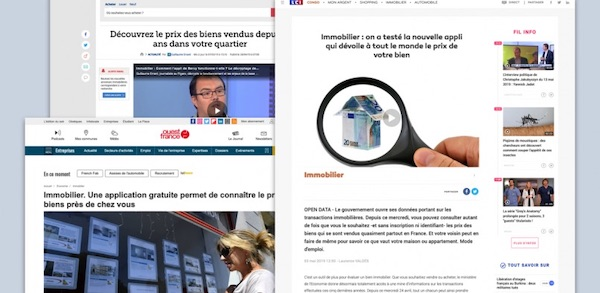On April 24, 2019, the General Directorate of Public Finance opened and put online the data it holds on sales of real estate and undeveloped land over the last five years. In order for this DVF ("Demande de valeur foncière") database to be visualized on a map without the need to download or manipulate it, the Etalab mission has developed a web application: app.dvf.etalab.gouv.fr.
Etalab thought it would reach a wider audience than the open data community.
"Against all odds," explains the Etalab mission on its blog, "our web application has received more than a million visits in less than two weeks ... The press coverage has brought a wider public to the application; a public that has come to look for information on its own transactions, as part of a real estate project, or simply curious about the prices charged in certain neighborhoods. And the user reviews have multiplied, leading us to make many more changes to the application.The etalab Mission draws, on its blog, a series of lessons from this achievement and success it has encountered.
- The visualizations reach more people than the raw data: "While app.dvf.etalab.gouv.fr was developed as a complement to the land value application database, the application quickly attracted more visitors than the DVF data itself - published as for them on data.gouv.fr. The site that was supposed to introduce the raw data was therefore quickly replaced by it. At the same time, what was only a small application developed in a short time and with few resources within Etalab, was often presented in the press as the main product of this operation.
- Setting up a server properly is never a bad idea: "It is possible to manage a significant influx of visitors without breaking the bank. We were able to welcome more than 180,000 people to the application on Friday, May 4 alone, on a relatively modest server, and by limiting the number of rejects thanks to prudent technological choices.
- Documenting is not a waste of time: "To give visitors some context, and to answer questions that kept coming back to our ears, we posted a FAQ (Frequently Asked Questions) a few hours after the app was released."
- Gathering feedback helps improve the user experience: "In addition to the problems of compatibility of the application with certain browsers, the implementation of the "Your opinion matters" questionnaire allowed us to identify other problems: we realized that several users did not really understand how the application worked. (...) We have learned that we are not our users and that nothing can replace the opinions of people from the outside.
- Making code public makes it better: "Putting the code of an application under development on GitHub, in a public repository, is like exposing unfinished work that is still far from perfect. But publishing the code has also allowed us to get some very useful feedback."
- Criticism is part of the game: "While we received praise, we also received some criticism. Some of the criticism was constructive, some was a little less so. On our side, we knew that our application was far from perfect. So we capitalized on the useful criticisms, the ones that pulled us up, without dwelling on the others.
Référence :





